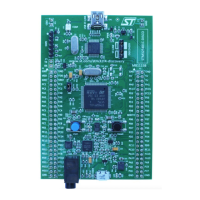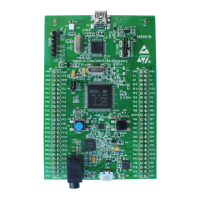Serial peripheral interface/ inter-IC sound (SPI/I2S) RM0402
830/1163 RM0402 Rev 6
The BSY flag is cleared under any one of the following conditions:
• When the SPI is correctly disabled
• When a fault is detected in Master mode (MODF bit set to 1)
• In Master mode, when it finishes a data transmission and no new data is ready to be
sent
• In Slave mode, when the BSY flag is set to '0' for at least one SPI clock cycle between
each data transfer.
Note: It is recommended to use always the TXE and RXNE flags (instead of the BSY flags) to
handle data transmission or reception operations.
26.3.13 SPI error flags
An SPI interrupt is generated if one of the following error flags is set and interrupt is enabled
by setting the ERRIE bit.
Overrun flag (OVR)
An overrun condition occurs when the master or the slave completes the reception of the
next data frame while the read operation of the previous frame from the Rx buffer has not
completed (case RXNE flag is set).
In this case, the content of the Rx buffer is not updated with the new data received. A read
operation from the SPI_DR register returns the frame previously received. All other
subsequently transmitted data are lost.
Clearing the OVR bit is done by a read access to the SPI_DR register followed by a read
access to the SPI_SR register.
Mode fault (MODF)
Mode fault occurs when the master device has its internal NSS signal (NSS pin in NSS
hardware mode, or SSI bit in NSS software mode) pulled low. This automatically sets the
MODF bit. Master mode fault affects the SPI interface in the following ways:
• The MODF bit is set and an SPI interrupt is generated if the ERRIE bit is set.
• The SPE bit is cleared. This blocks all output from the device and disables the SPI
interface.
• The MSTR bit is cleared, thus forcing the device into slave mode.
Use the following software sequence to clear the MODF bit:
1. Make a read or write access to the SPIx_SR register while the MODF bit is set.
2. Then write to the SPIx_CR1 register.
To avoid any multiple slave conflicts in a system comprising several MCUs, the NSS pin
must be pulled high during the MODF bit clearing sequence. The SPE and MSTR bits can
be restored to their original state after this clearing sequence. As a security, hardware does
not allow the SPE and MSTR bits to be set while the MODF bit is set. In a slave device the
MODF bit cannot be set except as the result of a previous multimaster conflict.
